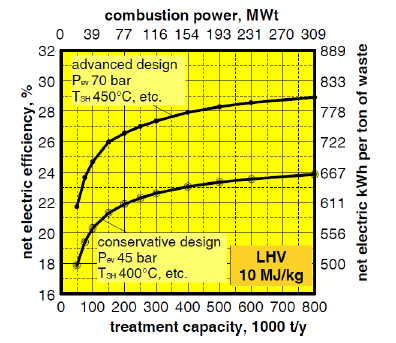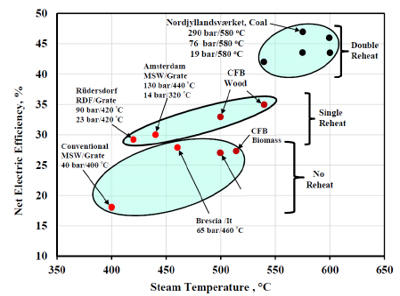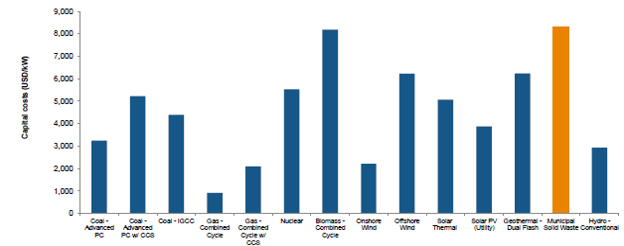Renewable Energy Basics
Waste-to-Energy (W-t-E) Technologies
Goal
Identify and advance the best available waste-to-energy (WTE) technologies for the recovery of energy or fuels from municipal solid wastes (MSW)
Technologies
Normally two technologies are in use-
- Mass Burn (MB) – refuse is burned in MSW combustors in as-received condition without any pre-processing, refuse is pushed into furnace with feed rams and moved through 2 or 3 sections using reciprocating grates; recovery of recyclables like metals and overs is done post-combustion.
- Refuse Derived Fuel (RDF) – recyclables like ferrous and non-ferrous metals, glass, rubber etc. are segregated; refuse is processed through hammer mills, shredded, screened and sprayed into combustion chambers.
Combustion process and treatment and disposal of pollutants:
Combustion of waste as fuel results in generation of heat and release of flue gases and ash.
Heat generated is used to produce high pressure superheated steam from water which is used either to run a steam turbine coupled with a generator to produce electricity or simply used to provide process steam.
Flue gases are treated in Air Pollution Control (APC) system for capture of acid gases, mercury, nitroxides, sulfur dioxide, etc. using activated carbon, Semi Dry Scrubber (SDA) and flue gas de-sulfurization (FGD) system etc., and particulate matter (PM) in flue gases are precipitated using Fabric Filters (FF) or Electrostatic Precipitators (ESP), or a combination of both.
Ash from FGD and Fly ash (FA) collected in FF bag houses and ESP is mixed with bottom ash (BA) and siftings from furnace bottom. The combined ash (CA) is treated to immobilize hazardous heavy metals.
Depending on ash treatment options, ferrous and non-ferrous metals can be recovered and the remaining ash can either be recycled for use in road construction etc., or is disposed of in sanitary landfills along with other MSW stream collected or diverted from W-t-E facilities.
Energy output:
One tonne of waste can deliver on an average 400 to 700 kWh of electricity to the grid.
The energy output depends on the W-t-E technology, combustion and steam generation parameters and the scale of the W-t-E plant’s refuse combustion capacity.
 Source: Consonni, Vigao and Bogale (2014)
Source: Consonni, Vigao and Bogale (2014)
Cost comparison:
W-t-E remains a costly option for energy generation, in comparison with other established power generation sources and also when compared with option of landfilling for waste management.
Environmental Stewardship:
The need to increase the share of renewable energy and reduce GHG emissions, along with raising environmental consciousness to protect the environment from polluting and unsustainable practices such as landfilling, will have a positive impact on W-t-E market development.
W-t-E efficiencies:
The efficiencies of W-t-E plants are affected by the very heterogeneous nature of the refuse and high moisture and ash contents. The productivity of these plants is also affected because of the smaller scales at which they operate and seasonality of the refuse collected.
 RDF – Refuse Derived Fuel CFB – Circulating Fluidized Bed
Examples from some US/European plants with diff. technologies
RDF – Refuse Derived Fuel CFB – Circulating Fluidized Bed
Examples from some US/European plants with diff. technologies
Source: Cosonni, Vigano & Eremed (2014), Themelis and Reshadi (2009)
Investment costs:
According to World Energy Council 2016 report, investment costs for W-t-E incineration plants range from US $300/yearly ton capacity for low-income countries to US $900/yearly ton capacity for high-income countries (EU and North America).
These costs can be lowered if plants with larger incineration capacities are installed, but the costs go higher for the smaller capacity incineration plants – in the range of, say 100,000 tons/year (about 300 tons/day capacity, operating at 90% utility rate, i.e. operating for 330 days in a year).
Capital costs comparison (US $/kWh) in US for various power generation sources (EIA, 2013):

